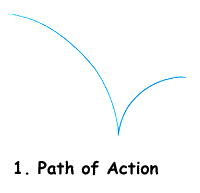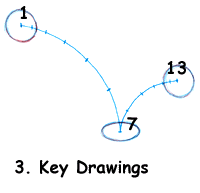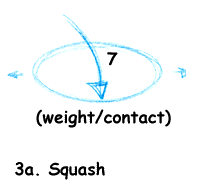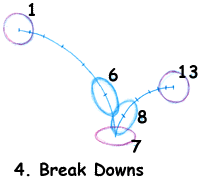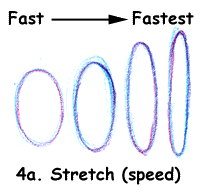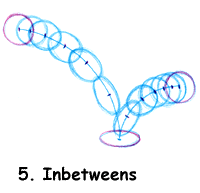|
|
|
|||||||||||||||||||
|
|
Let's
begin by drawing a path of action from
left to right. This is the path the ball
will follow. Remember to stay "ruff" and
"loose" with your drawings. As is the case
with most animation, our path of action is
made up of ARCS. TIP:
Most objects, characters, etc. move in
ARCS and NOT in straight
lines. Next
we will plan the timing of the ball along
our path of action. Draw tick marks. This
will help us figure out the positions (on
the arc) of the ball and the timing of the
bounce. Tick marks at the beginning (the
top of the arc) are close together; as the
ball heads down, the tick marks become
further and further apart. The
action at the beginning of an arc is called a
"slo-in". Once the ball hits - it looses a
little momentum and then slows down
(slo-out) as it approaches the top of the
next arc. TIP:
Think
of a ball rolling down a hill. It gains speed. Now
we have created a guide for our timing. NOTE:
Drawing #7 is where the ball makes contact, or
impacts with the ground. #7 is the "squash"
drawing, i.e., where we show the illusion of weight
or impact of the object (3a). TIP:
The
illusion of weight is very important. To maintain
the integrity of the ball, be sure to maintain the
same volume in drawing #7 (even though it is
"squashed") as you have in drawings #1 and 13.
Also, the faster the object, character, etc. moves,
the more "squash" you have when it hits. TIP:
Notice
that the ball goes from stretch directly to squash
and back to stretch (# 6, #7, #8) with no
"transition drawings". This gives snap to the
ball's bounce. Finally,
we draw in the rest of the inbetweens - #2
to #5; and #9 to #12. Notice that as the
ball falls, the shape "transitions" from a
round ball to more and more of an
eliptical or stretched shape. KEY
POINTS TIPS All
images copyright © Larry Lauria, 1999 |
